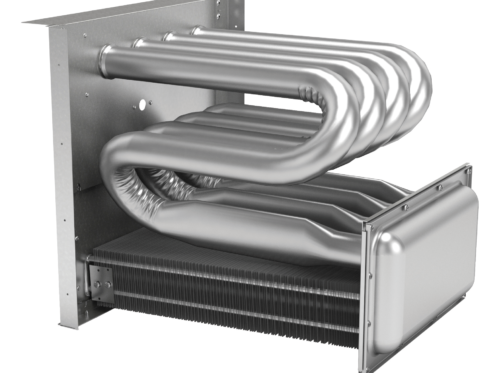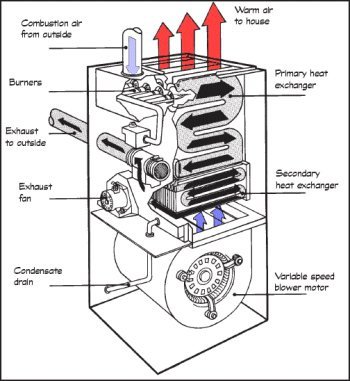Most homeowners are not aware of the presence of a heat exchanger in their furnaces until the furnace has a problem or it needs to be repaired. Just like any other mechanical device, a heat exchanger is likely to develop problems when used over time. When it is unable to work, it may lead to cracks in the system, resulting in unsafe levels of carbon monoxide emission due to incomplete combustion of fuel. Each furnace contains a heat exchanger, which is essential to its functioning. Furnaces are designed to ensure the gases emitted from them are safe to breathe. A heat exchanger is a metal shield between the combustion chamber and the blower that works to dispense heated air from the furnace into your home. If you’re located in or near San Marcos, CA. and your furnace has any problems, have a skilled technician from Oak Island Heating and Air Conditioning evaluate the system.
How a Heat Exchanger Works
A heat exchanger mixes cold air and heated air, enabling heat transfer so that the furnace attains equilibrium. This exchange allows the cold air to increase and hot air to reduce temperature to make sure the air is properly warmed for the home. Heat exchangers come in different types that have a diverse range of materials to help them work.
Most efficient furnaces have a primary heat exchanger and a secondary heat exchanger. The primary heat exchanger is found near the burners in the furnace. This part has the hottest flue gas. The flame from the furnace subjects the heat exchanger to immense heat, which can result in cracking. Furnaces with only one heat exchanger are only up to 80% efficient.
The secondary heat exchanger makes a furnace more than 90% efficient in heating your home’s air. The secondary heat exchanger accepts combustion heat exhaust from the primary heat exchanger. It provides more heat from the flue gas, forcing water vapor to change its state to liquid, releasing latent heat into the secondary heat exchanger.
This process makes the furnace much more efficient. Secondary heat exchangers are made from stainless steel or coated steel materials that can withstand heat, moisture, and acid.
Typical heat exchanger components include shells, tubes, spiral tubes, plates, fins, and adiabatic wheels. Metals are highly suitable for use in heat exchangers, especially strong metals that would not crack when exposed to excess heat. Heat exchangers can be made from two systems, either the tube system or the coils system, both of which connect to the burner and the flue pipe. They can also be made from plate exchangers constructed of thin corrugated plates to create a channel through which one gas can flow. Bolts, welding, and brazing conjoin them.
Heat exchangers should be completely sealed to ensure no leakage of carbon monoxide unheated air or flue gases. Flue gases are usually blown out of the building. However, more efficient heating systems pull more heat from them in a second furnace heat exchanger. This extra heat is used to warm the building further.
Caring for Your Heat Exchanger
As you would with any other mechanical device, you will need to care for your heat exchanger to guarantee its longevity and efficiency. You should ensure your heat exchanger undergoes routine inspection and tune-ups from a licensed technician from Oak Island Heating and Air Conditioning. Our technician checks for cracks in the system and repairs them to ensure no leakage of gases. They also check for other problems such as wear that could lead to future damage to the heat exchanger and eventually affect airflow. The technician will also clean the vents. Dirty vents block airflow in the heat exchanger, which reduces the efficiency of the equipment. The dirt may also cause overheating of the components of the heat exchange system, leading to cracks in that system.
The air filter should also be changed regularly according to the manufacturer’s specifications. Most quality filters should be okay for three to six months, but a poorly rated one might only last a month or so. Changing the filter should be done more frequently during the cold season when the system is being used on a regular basis.
Your air vents should always be open in the home to facilitate the airflow in the system. When the airways are blocked, airflow issues may damage the heat exchanger as it struggles to pull in the air. This could result in unexpected repair costs for the device. Ensure you care for your heat exchanger and schedule regular maintenance service with qualified technicians from Oak Island Heating and Air Conditioning to get the best out of the equipment.
How to Know If Your Heat Exchanger Has a Problem
If you notice the following, there could be a problem with the heat exchanger in your furnace. First, there might be a strange smell in your house like formaldehyde. This peculiar smell may come from the release of unwanted gases into the home or inappropriate combustion and cooling. Also, you may notice soot buildup in your air filters and around the burners. Soot buildup may be attributed to dirt in the system and uneven combustion. Another sign that your heat exchanger is faulty might be the formation of cracks in other parts of the furnace and corrosion of the metal parts such as the inducer motor.
If the flame produced by your burner is not blue, then the heat exchanger may be faulty. If you hear rattling and popping sounds in your system, this could be a cause of concern. These issues may be due to a crack that makes noise during the expansion and contraction when heating. Also, if you notice carbon monoxide in your home, this could be a sign of a faulty heat exchanger. Therefore, a carbon monoxide detector should be installed in your house. You should also make sure you consult qualified technicians from Oak Island Heating and Air Conditioning to come and inspect your furnace for any carbon monoxide leakage.
Benefits of a Heat Exchanger
The heat exchanger in a furnace helps keep the air in the building safe by making sure the flue gases do not mix with the air you breathe. Flue gases are dangerous to humans and may cause serious illnesses. It’s worth repeating that the possibility of having flue gases in your home makes it necessary to install carbon monoxide detectors in the house. The heat exchanger is also crucial in mixing hot and cold air to create a blend of warm air that will make the home warm and comfortable for the occupants.
Contact Oak Island Heating and Air Conditioning in San Marcos to get the best services for your heat exchanger at an affordable price. We offer inspection of your heating systems, repairs of the system in case of any problems and complete replacement of the system if a problem is too serious to be fixed. Before summer arrives, remember that we do the same for cooling systems. We also provide indoor air quality services, whole-house fans, smart thermostats, heat pumps, and more. The highly trained technicians on our team are certified by the NATE, and we’re accredited by the BBB. Ours is a family business with roots that go back to 1984. Call us today to discuss your home comfort needs.



